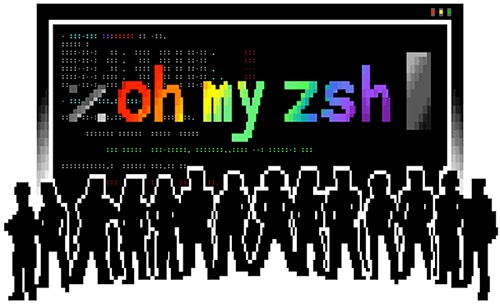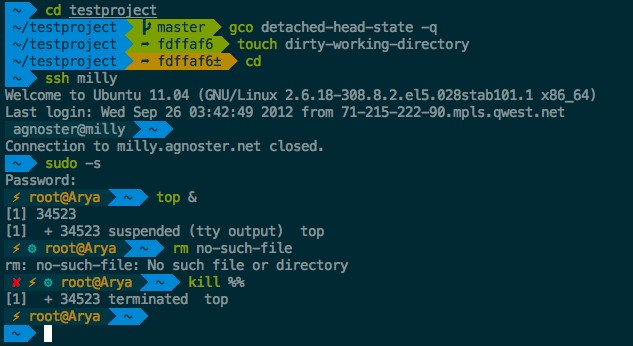Oh My Zsh, a powerful open-source framework, is here to revolutionize your zsh configuration. At WHAT.EDU.VN, we understand the need for efficient and user-friendly tools, and Oh My Zsh perfectly fits the bill. This guide will explore its features, benefits, and how it can transform your command-line experience. Learn how to customize your terminal, improve productivity, and enjoy a visually appealing and efficient workflow with enhanced shell scripting.
1. Understanding Oh My Zsh: An Overview
Oh My Zsh is more than just a tool; it’s a community-driven framework designed to manage zsh configurations. It takes the often-intimidating task of customizing your terminal and makes it accessible and enjoyable.
1.1. What Exactly Is Oh My Zsh?
Oh My Zsh is an open-source framework built on top of the Zsh (Z shell) command-line interpreter. It bundles a variety of plugins and themes that customize and extend the functionality of your terminal.
1.2. Key Features and Benefits
- Plugins: Enhance your workflow with plugins that provide shortcuts, autocompletion, and integrations for various tools and programming languages.
- Themes: Personalize the look and feel of your terminal with visually appealing themes.
- Easy Customization: Quickly customize your terminal to suit your preferences and workflow.
- Community Support: Benefit from a vibrant community that provides support, plugins, and themes.
- Increased Productivity: Streamline your workflow with powerful features and customizations.
1.3. Who Should Use Oh My Zsh?
Oh My Zsh is designed for anyone who uses the command line extensively, including:
- Developers: Streamline coding and development tasks.
- System Administrators: Manage systems more efficiently.
- Students: Enhance learning and project management.
- Anyone who wants a more powerful and customizable terminal experience.
Alt: Oh My Zsh terminal display with a customized theme and helpful command prompts.
2. Installing Oh My Zsh: A Step-by-Step Guide
Installing Oh My Zsh is straightforward, but it requires a few prerequisites. Let’s walk through the installation process.
2.1. Prerequisites
Before installing Oh My Zsh, ensure you have the following:
- Zsh: Zsh must be installed on your system. Most modern operating systems either come with it pre-installed or have it readily available in their package repositories. To check if Zsh is installed, open your terminal and type
zsh --version. If it’s not installed, refer to your operating system’s documentation on how to install it. - curl or wget: These tools are used to download the installation script from the internet. Most systems have
curlpre-installed. If not, you can installwgetusing your system’s package manager. - git: Git is essential for managing and updating Oh My Zsh and its plugins. Ensure Git is installed and configured on your system.
2.2. Basic Installation Methods
Oh My Zsh provides several installation methods using curl, wget, or fetch. Choose the one that works best for you.
2.2.1. Using curl
Open your terminal and run the following command:
sh -c "$(curl -fsSL https://raw.githubusercontent.com/ohmyzsh/ohmyzsh/master/tools/install.sh)"2.2.2. Using wget
If curl is not available, use wget:
sh -c "$(wget -O- https://raw.githubusercontent.com/ohmyzsh/ohmyzsh/master/tools/install.sh)"2.2.3. Using fetch
Alternatively, you can use fetch:
sh -c "$(fetch -o - https://raw.githubusercontent.com/ohmyzsh/ohmyzsh/master/tools/install.sh)"These commands download and execute the installation script, which automatically configures Zsh and installs Oh My Zsh.
2.3. Alternative Installation URL
If you encounter issues with the primary URL (e.g., due to network restrictions), use the alternative URL:
2.3.1. Alternative curl
sh -c "$(curl -fsSL https://install.ohmyz.sh/)"2.3.2. Alternative wget
sh -c "$(wget -O- https://install.ohmyz.sh/)"2.3.3. Alternative fetch
sh -c "$(fetch -o - https://install.ohmyz.sh/)"2.4. Post-Installation Steps
After the installation completes, a new .zshrc file is created in your home directory. Your previous configuration file is renamed to .zshrc.pre-oh-my-zsh. You can move any custom configurations from the old file to the new one.
2.5. Manual Inspection
For security reasons, inspect the installation script before running it. Download the script and review its contents:
wget https://raw.githubusercontent.com/ohmyzsh/ohmyzsh/master/tools/install.sh
sh install.shIf the above URL times out, substitute it with https://install.ohmyz.sh.
3. Configuring Oh My Zsh: Plugins and Themes
Once installed, Oh My Zsh is highly configurable through plugins and themes.
3.1. Understanding Plugins
Plugins are extensions that add functionality to your terminal. They can provide autocompletion, aliases, and integrations for various tools.
3.1.1. Enabling Plugins
To enable plugins, edit the .zshrc file in your home directory:
vi ~/.zshrcLocate the plugins section and add the names of the plugins you want to enable. For example:
plugins=(git bundler docker composer node npm)Ensure the plugin names are separated by spaces, not commas.
3.1.2. Popular Plugins
- git: Enhances Git usage with aliases and status information.
- docker: Provides autocompletion and aliases for Docker commands.
- node: Adds autocompletion for Node.js commands.
- npm: Enhances npm usage with aliases and autocompletion.
- python: Provides utilities for Python development.
3.1.3. Using Plugins
Each plugin comes with its own set of features and aliases. Consult the plugin’s documentation for details on how to use it. Most plugins include a README file that outlines their functionality.
3.2. Themes: Personalizing Your Terminal
Themes change the appearance of your terminal, making it more visually appealing and informative.
3.2.1. Selecting a Theme
To select a theme, edit the .zshrc file and modify the ZSH_THEME variable:
ZSH_THEME="robbyrussell"Replace "robbyrussell" with the name of the theme you want to use. Oh My Zsh comes with many built-in themes.
3.2.2. Popular Themes
- robbyrussell: The default theme, providing a clean and functional look.
- agnoster: A popular theme that displays Git branch and status information.
- powerlevel10k: A highly customizable theme known for its speed and flexibility.
- spaceship: A minimalist theme with a focus on information density.
- avitic: A simple and elegant theme with a clean layout.
3.2.3. Applying Themes
After changing the theme, open a new terminal window or run source ~/.zshrc to apply the changes.
3.2.4. Random Themes
For a bit of fun, set the theme to random to have a new theme each time you open a terminal:
ZSH_THEME="random"You can also specify a list of favorite themes to choose from randomly:
ZSH_THEME_RANDOM_CANDIDATES=( "robbyrussell" "agnoster" "spaceship" )Additionally, you can exclude themes you don’t like:
ZSH_THEME_RANDOM_IGNORED=( "pygmalion" "tjkirch_mod" )Alt: Example of the Agnoster theme in Oh My Zsh, showing Git branch and status information.
3.3. Troubleshooting Theme Issues
If your theme doesn’t look right (e.g., strange characters), you may need to install a Powerline Font or a Nerd Font. These fonts provide the necessary glyphs for many themes to render correctly.
Themes only control the appearance of your prompt. Terminal colors and fonts are set separately in your terminal emulator settings.
4. Advanced Oh My Zsh Configuration
For users who want more control, Oh My Zsh offers several advanced configuration options.
4.1. Custom Directory
You can change the installation directory by setting the ZSH environment variable before running the installer:
ZSH="$HOME/.dotfiles/oh-my-zsh" sh install.sh4.2. Unattended Installation
For automated installations, use the --unattended flag to prevent the installer from changing the default shell or running Zsh:
sh -c "$(curl -fsSL https://raw.githubusercontent.com/ohmyzsh/ohmyzsh/master/tools/install.sh)" --unattended4.3. Installing from a Forked Repository
To install from a forked repository, use the REPO, REMOTE, and BRANCH variables:
REPO=apjanke/oh-my-zsh BRANCH=edge sh install.sh4.4. Manual Installation Steps
For a manual installation:
- Clone the repository:
git clone https://github.com/ohmyzsh/ohmyzsh.git ~/.oh-my-zsh- Backup your existing
~/.zshrcfile:
cp ~/.zshrc ~/.zshrc.orig- Create a new Zsh configuration file:
cp ~/.oh-my-zsh/templates/zshrc.zsh-template ~/.zshrc- Change your default shell:
chsh -s $(which zsh)- Log out and back in to apply the changes.
4.5. Custom Plugins and Themes
Create custom plugins and themes by adding .zsh files to the custom/ directory. Place custom plugins in custom/plugins/ and enable them in your .zshrc file.
4.6. Skipping Aliases
You can skip default Oh My Zsh aliases by using zstyle in your ~/.zshrc file:
zstyle ':omz:*' aliases no # Skip all aliases
zstyle ':omz:lib:*' aliases no # Skip aliases in lib files
zstyle ':omz:plugins:*' aliases no # Skip all plugin aliases4.7. Async Git Prompt
Enable asynchronous prompt rendering for Git information to improve performance:
zstyle ':omz:alpha:lib:git' async-prompt yes5. Maintaining Oh My Zsh: Updates and Uninstallation
Keeping Oh My Zsh up to date ensures you have the latest features and bug fixes.
5.1. Updating Oh My Zsh
By default, Oh My Zsh checks for updates every two weeks. You can configure the update mode in your ~/.zshrc file:
zstyle ':omz:update' mode auto # Automatic updates
zstyle ':omz:update' mode reminder # Reminders for updates
zstyle ':omz:update' mode disabled # Disable updatesTo manually update, run:
omz update5.2. Uninstalling Oh My Zsh
To uninstall Oh My Zsh, run:
uninstall_oh_my_zshThis command removes Oh My Zsh and restores your previous Zsh configuration.
6. Frequently Asked Questions (FAQ)
Here are some common questions about Oh My Zsh.
| Question | Answer |
|---|---|
| What Is Oh My Zsh used for? | Oh My Zsh manages configurations and extends the functionality of the Zsh shell with plugins and themes. |
| How do I install a plugin? | Add the plugin name to the plugins array in your ~/.zshrc file. |
| How do I change the theme? | Modify the ZSH_THEME variable in your ~/.zshrc file. |
| Why does my theme look strange? | You may need to install a Powerline Font or a Nerd Font for the theme to render correctly. |
| How do I update Oh My Zsh? | Run omz update in your terminal. |
| How do I uninstall Oh My Zsh? | Run uninstall_oh_my_zsh in your terminal. |
| Can I create my own plugins and themes? | Yes, you can create custom plugins and themes by adding files to the custom/ directory. |
| Is Oh My Zsh free to use? | Yes, Oh My Zsh is an open-source project released under the MIT license. |
| What are some popular plugins? | git, docker, node, npm, python are some of the popular plugins. |
| Where can I find more information about themes? | Check the Oh My Zsh Themes wiki page for a list of available themes and previews. |


7. Community and Support
Oh My Zsh has a vibrant community of users and contributors. You can find support and contribute to the project through the following channels:
- GitHub: Report issues, contribute code, and participate in discussions.
- X (formerly Twitter): Follow @ohmyzsh for updates and news.
- Discord: Join the Oh My Zsh Discord server for real-time chat and support.
8. Conclusion: Transform Your Terminal Experience
Oh My Zsh is a powerful tool that can significantly enhance your terminal experience. With its extensive collection of plugins and themes, it allows you to customize your terminal to suit your workflow and preferences. At WHAT.EDU.VN, we encourage you to explore the possibilities and unlock the full potential of your command line.
Ready to take your terminal to the next level? Experience the convenience and power of a customized command-line environment with Oh My Zsh. If you have more questions or need personalized assistance, visit WHAT.EDU.VN. Our community of experts is here to provide fast, accurate, and free answers to all your questions.
Address: 888 Question City Plaza, Seattle, WA 98101, United States
WhatsApp: +1 (206) 555-7890
Website: WHAT.EDU.VN
Don’t hesitate—ask your question on what.edu.vn today and discover the power of community knowledge.